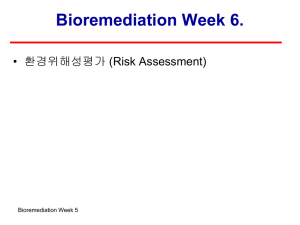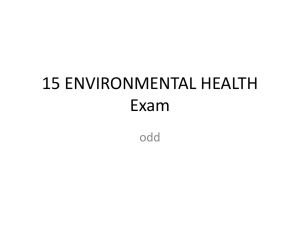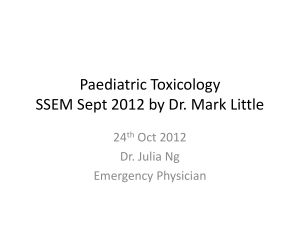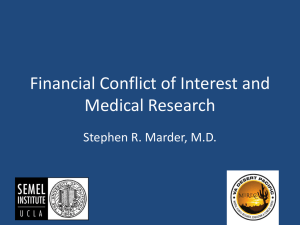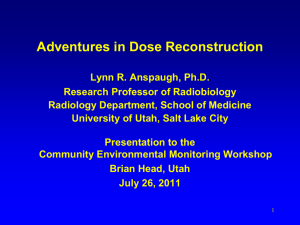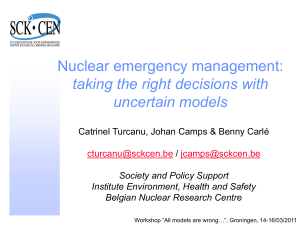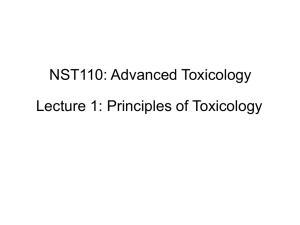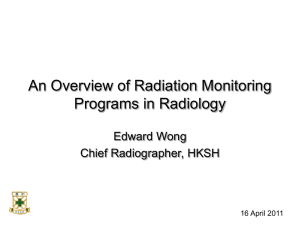Selected Silver Book Highlights and Update on Related Activities
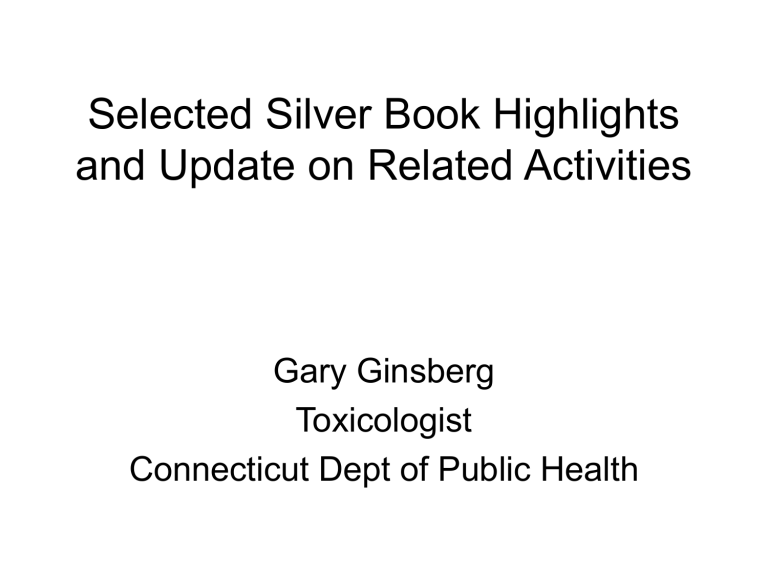
Selected Silver Book Highlights and Update on Related Activities
Gary Ginsberg
Toxicologist
Connecticut Dept of Public Health
Challenges to Risk Assessment 25 Years
After the Red Book
Precautionary Principle
Cost Benefit
The 2 Silos Human Health Risk Assessment
Emerging
Technologies
Multiple Chemicals
The dioxin syndrome
SCIENCE AND DECISIONS:
ADVANCING RISK ASSESSMENT
National Research Council
Committee on Improving Risk Analysis Approaches Used by EPA
Board on Environmental Studies and Toxicology
Report Overview
• Make RA more solutions oriented, decision-based
• Uncertainty and Variability
• Unification of cancer and non-cancer RA
– New definition of RfD
– Low dose linear approach for non-carcinogens
– Variability into cancer RA
• Defaults
– Hidden default of zero risk for chems with little data
• Community risk –combined effects of diff stressors
Risk Policy Report, Vol. 17, No. 37 - September 14, 2010
Guest Perspective
The NRC Silver Book: The Case for Improving Non-Cancer
Risk Assessment
Gary Ginsberg, Connecticut Dept of Public Health, Hartford CT, Jonathan Levy,
Harvard School of Public Health, CambridgeMA, A. John Bailer, Miami University,
Oxford OH and Lauren Zeise, California EPA, Oakland CA
What’s Broken in Risk Assessment?
Two silos – Cancer vs. Non-Cancer
The Fix?
One Unifying Framework
Will it make regulation more complex?
Will it make regulations too stringent?
Is it consistent with the underlying science?
Factors that Contribute to Risk
Community Factors
Housing
Medical Care
Education
Stress
Host Factors
Genetics, Age
Lifestyle, Disease
Chemical Exp
Air, water, soil, consumer prod, food
Cumulative Risk
Disease??
Do the 2 silos help RA address variability and uncertainty?
tidy constructs, functional but imperfect representations
Threshold vs Non-Threshold
• Easy to define “safe” dose – RfD or RfC
• Uncertainty factors
• Yes / No answer
• Not useful for cost/benefit
• No “safe” dose
• No uncertainty factors
• Risk is a continuum to very low dose
• Probability of risk useful for cost/benefit
PM10 and Mortality in 20 US Cities
Daniels, et al. Amer J Epi 2000
Unified Approach for
Cancer and Non-Cancer
• Not based upon precaution
• Not making everything a carcinogen
• Not blowing up the RfD
=================================
• Organize around likelihood for threshold
– MOA
– Interaction with background dx, exposure
– Variability and vulnerability in pop
• Create a probability of risk for all endpoints
– Where practical
• Create framework better for cumulative risk
Conceptual Model 1
Linear at the Population Level
• Threshold exists at individual level
• Threshold different for different people
• As increase dose, recruit in the more resistant
• At population level, no threshold
– Even tiny doses have some finite risk
– More likely if already a significant background risk
– Intersection with aging or disease process
– Interaction with similarly acting agents
– Interaction with unique host vulnerability factors
• Possibility for a separate assessment for subgroups
• Examples: PM, mercury, lead, ozone, arsenic
• Analytical approach – linear slope at low dose that can be shallower than at high dose
1
0.8
0.6
0.4
0.2
0
0
Liver Spongiosis in Male Rats in Response to p-Dioxane
(Yam azaki, et al., 1994)
0.9
0.8
0.7
0.6
0.5
0.4
0.3
0.2
0.1
0
0 100 200 300 400
1,4-Dioxane Dose
500 600 700
Spongiosis in Female Rats
200 400
1,4-Dioxane Dose
600 800
What Happens at Low Dose??
100
90
80
70
60
50
40
30
20
10
0
0 5 10 15
Dose
20 25 30
Series1
Threshold??
RfD
100
90
80
70
60
50
40
30
20
10
0
0 5 10 15
Dose
20 25 30
No Threshold?? - Cancer
100
RfD
90
80
70
60
50
40
30
20
10
0
General Pop Affected
Vulnerable Affected
0 5 10 15
Dose
20 25 30
Conceptual Model 2
Threshold Both Individual & Pop
• Chemical MOA not mutagenic
– Toxicity can be quenched
• Defense, repair, homeostatic mechs
• Chemical not adding to background exp or dx
• Alachlor-induced hemolytic anemia
• Xenon-induced asphyxia
– Exposure levels below threshold across pop
• Background exposures, conditions, risk factors not boosting the dose response
• Analyze by distributions for each uncertainty
– Probability for harm
Conceptual Model 3
Linear at Individual Level
• Mutagens
– Probability of DNA damage, oncogene activation even at low dose
• Ozone?
– Probability that some percentage of dose effective even at very low doses within range of human exposure
• High / low dose slopes not necessarily the same
• Methods suggested for bringing variability into linear low dose assessment
Redefined RfD
• Not a bright line yes/no answer
• Dose assoc with some probability of harm
• Defines the risk at a given reference dose
• E.G., May be defined as
– Dose that with 95% confidence confers 1 in
1000 risk for a particular endpoint
• Acceptable level of risk could depend upon severity of endpoint
Upstream Biomarkers and
Thresholds
• Often a continuous variable
– Birth wt, sperm count, pulmonary fn, blood pressure, IQ points, TH levels, omics
– Can be concerned about slight shifts in the distribution even within the normal range
– Threshold? Possibly not if key biomarker
• Threshold applies if you can document a dose in the population below which there is no shift in the underlying distribution
– Including susceptible pops
Threshold on Pop Level More
Likely if:
• The pop distribution lies far from the clinical disease point
– Vulnerable subpopulations don’t exist
– Background dx rate is low or rare
– Chemical doesn’t contribute to something already in the pop
• There are no interacting background exposures
– Examples of chem interaction
• Ozone and PM, other irritants and oxidants
• Mercury – organic and inorganic
• Pesticides
• Phthalates
• Interactions at ER and AhR
Linear Low Dose Concepts
• Increasing risk with increasing dose
• Not necessarily the same slope as at high dose
– Possible to have curvilinear high dose and linear low dose
• Not all agents should be modeled linear low dose
– Interaction with background dx or aging process?
– Interaction with other chemical exposures?
So What if there is a threshold at some very low dose …. If….
• Within the range of common human exposure can’t demonstrate a threshold
– PM
– Ozone
– Hg
– Pb
– Phthalates
– PCBs
– Perchlorate
– BPA
– Arsenic
• Implication: low enviro levels of these agents cause or contribute via interaction with other factors
Toxic Chemicals May Interact with Disease Process
Carcinogens
PM
Mercury
Cancer
CardioPulm Dx
CV disease
Pb
TCE
Ozone
Attention Deficit
Autoimmune Dx
Arsenic
Diabetes
Early Estrogens
Obesity
Asthma
Benign?? / Contributory?? / Causative??
Application of Silver Book
Concepts for Low Dose Linear
• Pick low hanging fruit (e.g. Pb, Hg, Ozone)
– Develop a low dose slope from which the protectiveness of RfD can be explored
– How different is high dose and low dose slope?
– Is it better to address as separate subpops
• Explore other low dose slope approaches
– Actual Epi data
– Cancer model – POD to zero linear
– Background additivity model
– Variability (signal to noise model)
Exploring Interaction with
Background Dx/Aging Processes
• Collaborate with medical researchers
– What are key upsteam events and risk biomarkers for diabetes, ht dx, kidney dx, hypothyroid, cancer, etc.
– Does the chemical hit these events?
• Epi evidence of chemical ↑ing dx risk
• Animal models of the human dx to test dose response?
– TCE and mouse autoimmune model
• Griffin et al 2000; Blossom et al 2007
Variability Model to Address
Signal-to-Noise Issues
• Variability in large pop can create linear low dose
• Variability across a small pop can bury it
• Is there a low dose slope buried the noise?
– Signal to noise crossover dose not yet reached but doesn’t mean no signal
• Develop plausible bound on this low dose slope
– Statistical limit – e.g., 95% LCL on control response to
95% UCL on low dose response
• Constrained by high dose slope
• Variability by itself won’t create linear low dose
100
80
60
40
20
0
0
Plot Showing Plausible Bound on Low Dose Slope
20 40 60
Dose
80 100 120
Variability Burying Low Dose Slope in Small Pops
• Animal evidence – Festing et al.
– Strain diffs in CAP hematological response
– Outbred strains insensitive
• Human evidence – Huang and Ghio 2009
– Summary of controlled PM studies in cardiopulmonary patients
• Diminished responses relative to healthy subjects
• Too much variability in the small groups tested
– Impaired and variable baseline values makes it difficult to see an effect
– May need to focus on a narrower subpop- more severe patients
Festing et al
2001
CD-1
Background Additivity Model
• If there is background rate of toxic effect (e.g. dx, oxidative stress, ER binding)
– Convert background to chem “Effective” dose
– If 10 mg/kg/d causes 30% increase in urinary Beta
2 microglobulin excretion
-
– And 60 yr old men have 10% increase, then the starting dose in a 60 yr old man is 5 mg/kg/d
– If exposure in drinking water is at 0.1 mg/kg/d his overall dose is 5.1 mg/kg/d
– Risk @ 5.1 mg/kg/d – Risk 5.0 mg/kg/d = Risk associated with drinking water at 0.1 mg/kg/d
70
60
50
40
30
20
10
0
0
Dose Response for Metal Effects on Renal Tubular Function
5 10 15
Dose (mg/kg/d)
20 25
Hattis et al. 2009 – Analysis of TCDD Low Dose Risk
0.5
Plot of Observed Rat Cholangiocarcinoma
Incidence and Central Estimate of Hill Model
Fit to the Data Vs Human Equivalent Dose
Obs Fract Bile Duct Ca in Rats
Hill Mod Fit--Central Est of N
(25/53)
0.4
0.3
0.2
0.1
(4/49)
0.0
0
(0/49, 48 and 46)
(1/50)
2 4 6 8 10 12 14 16 18
Human Equivalent Dose (ng/kg-day)
[From Simple Body Weight^(-1/4) Projection]
20
Hattis et al. 2009 – Analysis of TCDD Low Dose Risk
Effect of an Interacting Background on the Incremental Risks of Various Lifetime Dose Rates of TCDD
1% of US Background Rate of Cholangiosarcoma Assumed Relevant (1.9E-05) ng/kg-day continuous
TCDD dose equivalent TCDD dose including backround
(ng/kg-day)
Total Risk incl bkgd for central (50h
%tile) estimate of n
Incremental risk after
Subtracting bkgd
Slope-incremental risk/ ng/kg-day from previous dose
1.00E-05
0.0001
0.001
0.01
0.1
1
10
0.36896
0.36905
0.36995
0.379
0.469
1.37
10.37
1.8770E-05
1.8783E-05
1.891E-05
2.02E-05
3.66E-05
7.26E-04
1.71E-01
1.10E-09
1.39E-08
1.42E-07
1.45E-06
1.79E-05
7.07E-04
1.71E-01
1.42E-04
1.42E-04
1.46E-04
1.82E-04
7.66E-04
1.89E-02
Combined Exposures
• How many kids in top 10 th % for Pb, As, Hg,
PCBs, Perchlorate
– Theoretically 0.1
5 ( 0.001%) of population or 1 in
100,000
– Biomonitoring with a purpose
• Similar considerations for anti-thyroid agents, pesticides, endocrine disruptors
• House dust a key source for children
– Phthalates
– PFOA/PFOS
– Lead
Useful Case Studies
• Ozone and airway response
• Methyl and Inorganic Mercury
– Fish and amalgam exposure
• Arsenic and neurodevelopment
• Binding to estrogen receptor
Ozone and Low Dose Linearity
• Direct effects – some % O
3 escapes antioxidant defenses even at low dose
– 1 ppt = 11 trillion molecules /hr
• Collateral effects – quenched O
3
↓s antioxidant defenses even at low dose
• Additive to background asthma
– Endogenous ozone poss during inflammation
• Large variability in threshold in population
% Effective Dose Related to Ozone
Antioxidant Capacity in URT
• Greater at high dose than low
– Overcome antioxidant defenses
– Still could have linear low dose slope
• Some ozone at low dose can escape defenses
• Define here as % O3 escaping URT lining fluid
• Baseline, low breathing rate– 17.5%
• Ultman et al.
– Measured OZAC in nasal lavage – 2 subjects
• Generate ozone in cuvette
• Dye bleached – color change correlates with O3
• If antioxidants present – less color change
• Approx 2 mM OZAC in undiluted nasal lining fluid
Ultman et al.
• OZAC depletion by O3 leads to greater ED
• Exposed subjects to 0.36 ppm x 30 min
• Went from 17.5 to 28.8% ED
• Approx 37% depletion of OZAC
• Should have been 100% in 8.9 mins
• OZAC repletion must be occurring
• Run simple one compartment model to backfit OZAC repletion rate
Inspired Ozone
(0.36 ppm)
URT
LRT
10 micron
0.16 ml
Effective Dose
Nasal Lining Fluid
Ozone loss = K*C
O3
*C
OZAC
OZAC depletion = Ozone loss
OZAC repletion = backfit
Percent Effective Dose At Two Different Ozone Concentrations
2.90E-01
2.70E-01
2.50E-01
2.30E-01
2.10E-01
1.90E-01
1.70E-01
1.50E-01
0 10 20 30 40
Time (sec)
50 60 70
0.36 ppm
0.05 ppm
100
90
80
70
60
50
40
30
20
10
0
10
Percent Effective Dose as a Function of Ozone Air
Concentration and OZAC Level
100
Ozone (ppb)
1000 10000
Baseline OZAC
50% OZAC
Bell et al. EHP 114: 532-536, 2006
Ozone and Mortality Data from 96 Cities
Brown et al. EHP 2008
Shore et al. J Appl Phys 95: 938-945 2003
Mercury: Why Carp on Cavities?
• Some fish contain methylHg of concern
• Effects partially balanced by O-3 FAs
• Dental amalgam: lower dose of Hg (Hg°)
• Some epi suggests amalgam safe
• More brain Hg in those with amalgams
– Below a toxicity threshold?
– Dentists – 100x > exposure than gen public
• neuro effects occur
• How do the amalgam data fit within Silver Book models?
35
30
25
20
15
10
5
0
0
Neonatal Rat Behavioral Response to
Prenatal Hg Exposure (Fredriksson et al. 1996). Dashed lines represent range of human brain Hg (Eggleston et al. 1987)
5 10
Brain Hg (ng/g)
15 20
Swimming Latency
Rearing Activity
Wasserman et al. 2004 Children’s Arsenic Water Exposure and Intellectual Function in Bangladesh
Wasserman et al. 2004
Estrogen Sensitive Diseases
Background chemical and dx additivity
• Breast Cancer and Endometriosis
– High background, estrogen driven
• Pop not doing a good job coping w/E within context of obesity, stress, other carcinogens
• Each E dose on pop level plausibly adds some risk
• Xenoestrogens may act differently than natural hormone
• Xenoestrogens early in life may lead to accentuated response to later estrogen
• Estrogens late life – breast cancer and HRT
Conclusions
• Numerous examples of non-cancer linear D-R
– Across large populations’
– Interaction with dx or other chemicals
– Key focus may be Pb, As, Hg and developmental neurotoxicity
• Approaches to estimate low dose effects
– Slope from Epi studies
– Default carcinogen approach
– Background additivity
– Variability (Signal/Noise) model
Conclusions
• Risk managers still use RfD in same way – just defined differently
– critical to cost-benefit analysis for non-cancer
• Not all chemicals will have linear low dose effects
– Important to document those as well
– Can still create probabilistic version of RfD
• Need to put variability into Conceptual
Model 3

